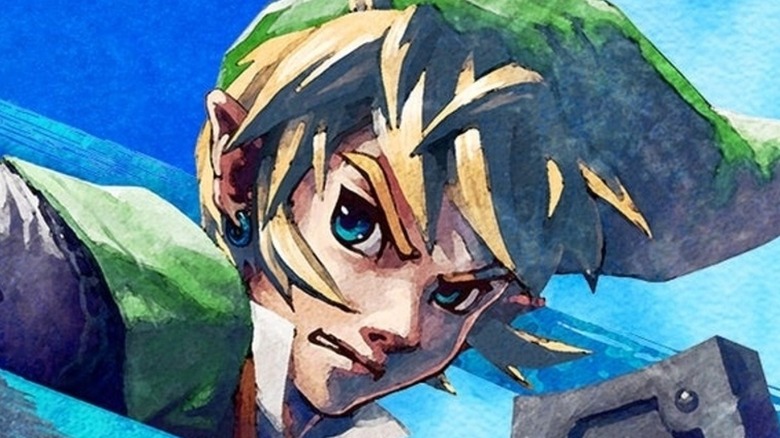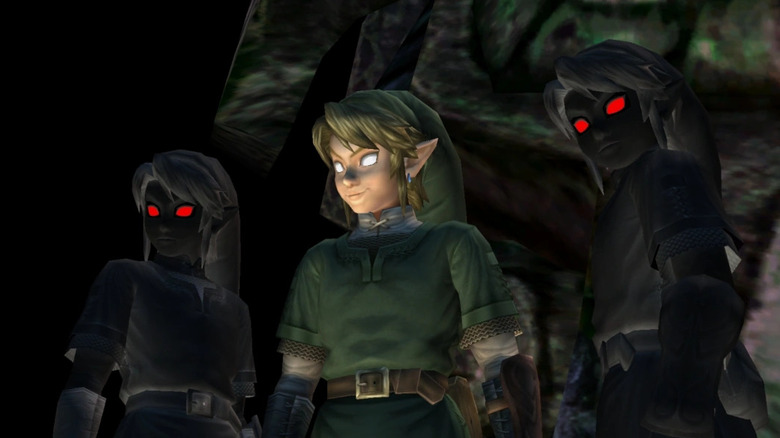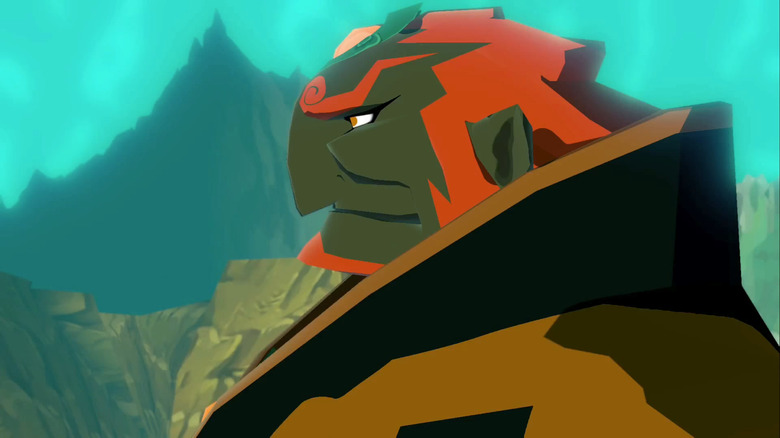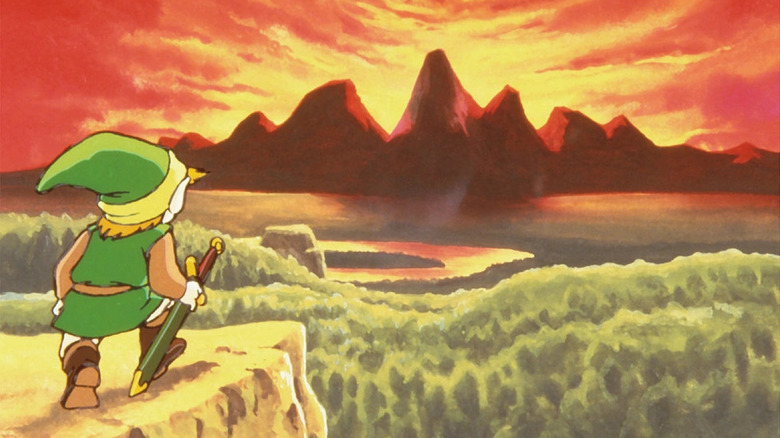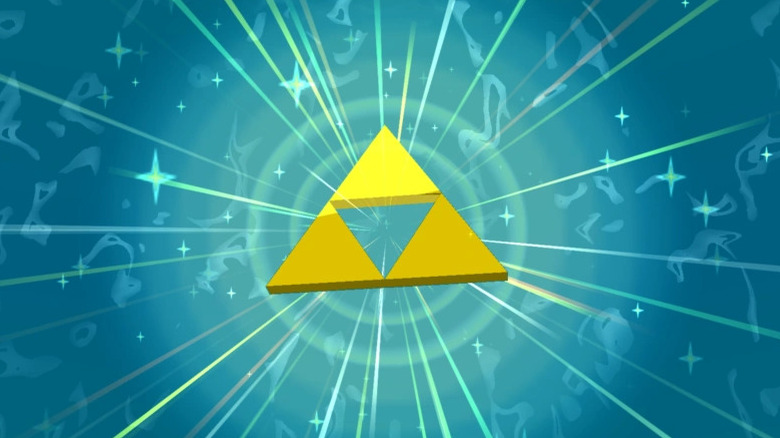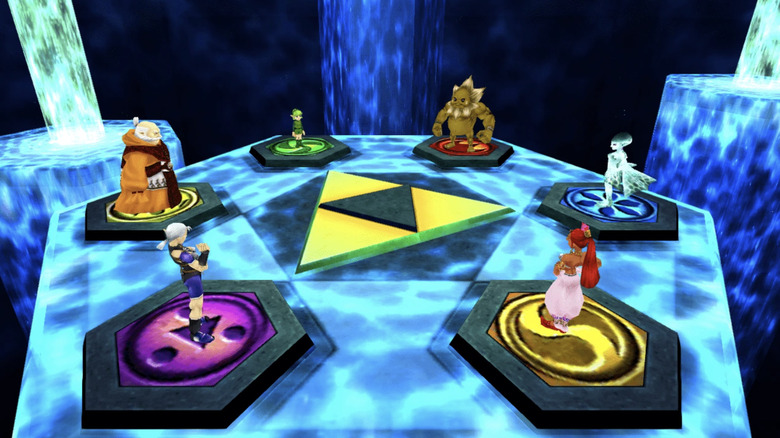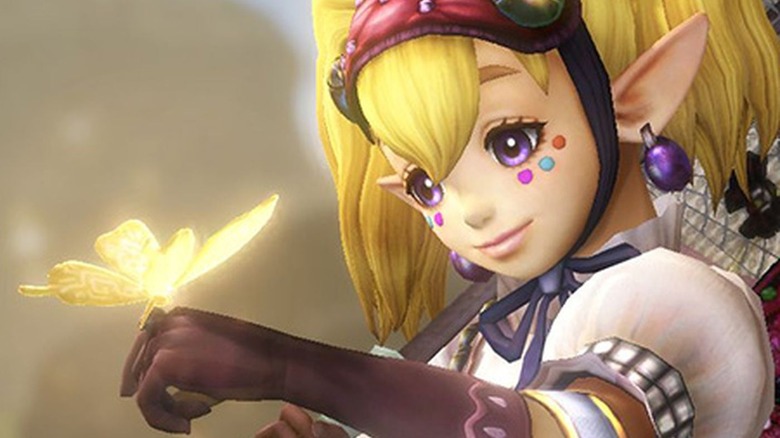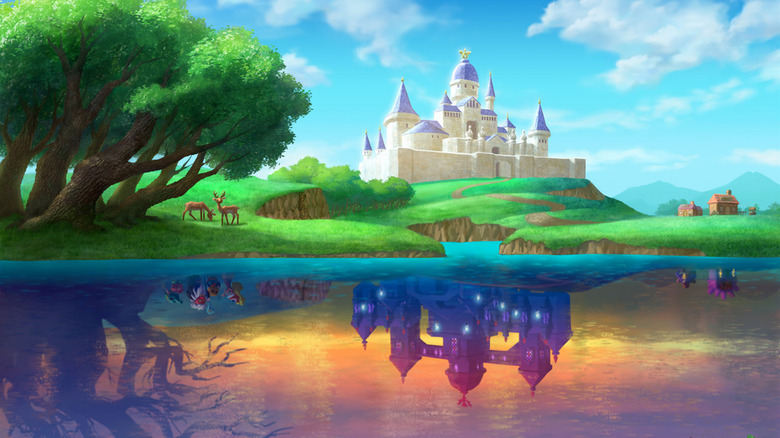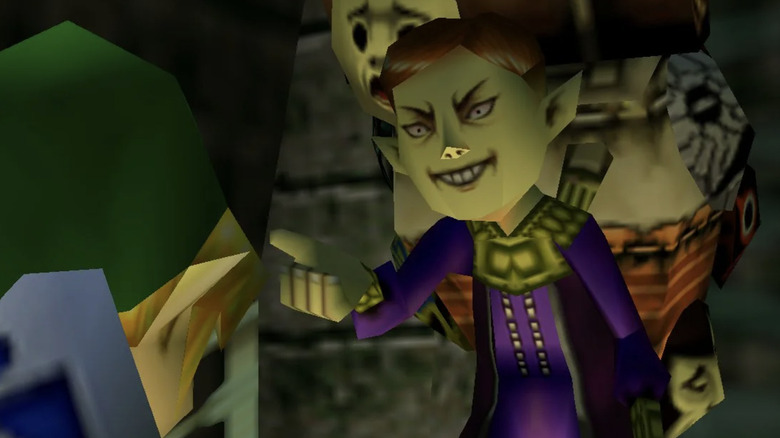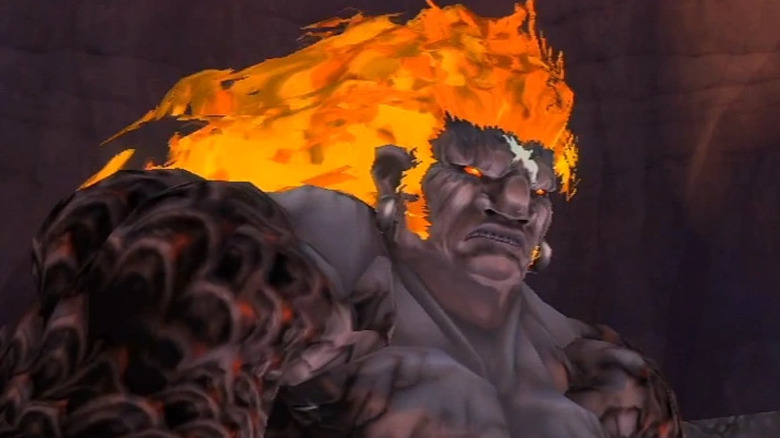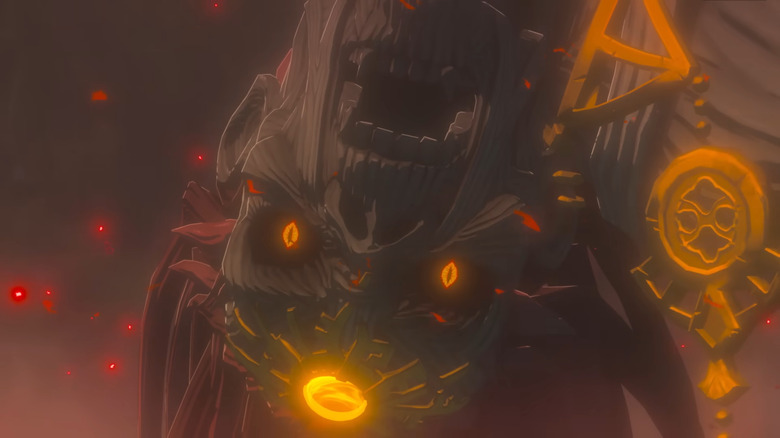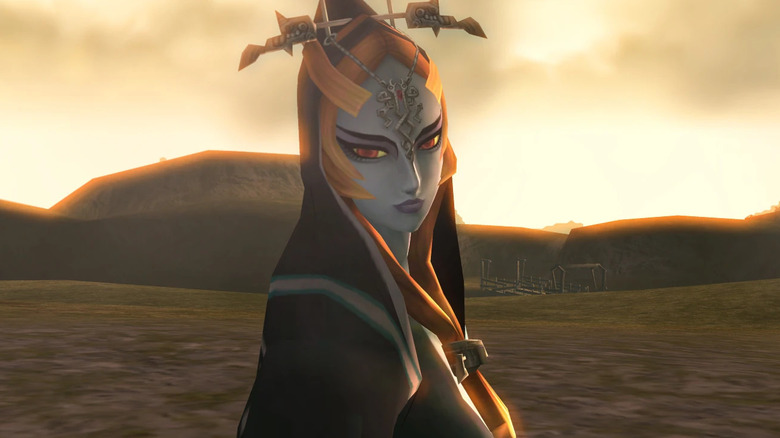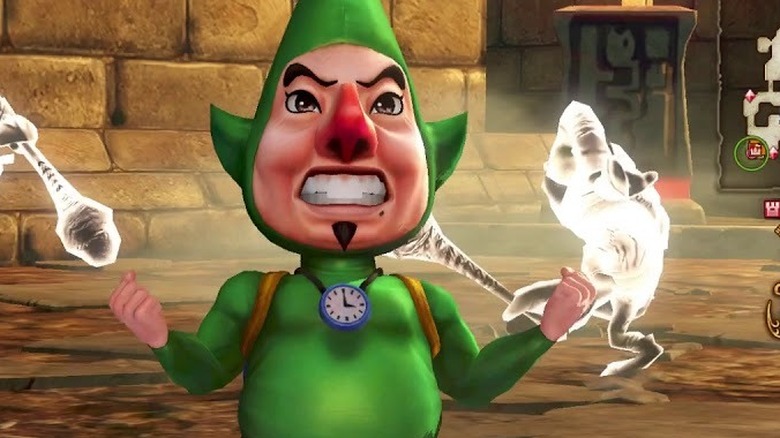The Legend Of Zelda Fan Theories That Completely Change The Series
"The Legend of Zelda" franchise's mythical storytelling often leaves its devotees with more questions than answers. Ancient prophecies, cycles of reincarnation, and the bending of time all contribute to a complex storyline. Deciphering the deeper meanings of "The Legend of Zelda" is the player's subjective responsibility.
"Hyrule Historia," released in 2011, attempted to turn certain aspects of "The Legend of Zelda" into official canon. Most notably, "The Legend of Zelda's" overall chronology was broken into three distinct (and seemingly official) timelines. However, "Hyrule Historia" does not give the full picture of the realm's history, as the book itself notes, "This chronicle merely collects information that is believed to be true at this time. There are many obscured and unanswered secrets that still lie within this tale. As the stories and storytellers of Hyrule change, so, too does its history."
Nothing more perfectly describes the pursuit of unanswered secrets than fan forums or various subreddits, where discussions of unique interpretations go through the crucible of gamers' scrutiny. There are countless fan theories surrounding "The Legend of Zelda," some of which branch in dozens of directions, but certain theories have solidified and refined themselves over the years.
Is it possible that most fan speculation is blown out of proportion, or that many perceived easter eggs are just harmless callbacks? Certainly. But that conclusion is nowhere near as fun as indulging some of these game-changing fan theories.
The world is better off without Link
The Hero of Time, Link, sometimes catches minor flack for his more insensitive qualities. His insistence on smashing pots and smacking innocent chickens, for instance, or his penchant for breaking-and-entering. These little qualms, though, are nothing compared to the idea that Link is actually the true villain of the "Legend of Zelda" franchise.
One widespread fan theory argues that Hyrule's best days are when Link is not around. Being the Hero of Time, Link is only reincarnated when a great evil presents itself. Put bluntly, Link only shows up when the ship is already sinking. In this light, Link might even be seen as a curse by some Hylians. A chicken-or-the-egg dichotomy exists between Link and Ganon.
The official three-timeline split from "Hyrule Historia" actually supports the idea that Hyrule might be better off without Link in many ways. In Golden Era — the timeline where Link is defeated by Ganon — required cooperation of the Knights of Hyrule and the Seven Sages to seal away Ganon on their own. That learned self-sufficiency was further embodied by the leaders of Hyrule learning to effectively using the Triforce for the betterment of the realm. They might never have done that if Link was around to bail them out.
Ganondorf is (sort of) a tragic anti-hero
The flipside of the "Link is the problem" theory recasts Ganondorf's villainy as the justified actions of a tragic anti-hero. Ganondorf, across nearly every title in the series, is seen as the ultimate evil. His covetous quest to complete the Triforce drives not just "Ocarina of Time" forward, but also the entire "Legend of Zelda" franchise. However, one speech he delivers in "The Wind Waker" has caused some debate regarding his unsympathetic nature.
At the very end of "The Wind Waker," Ganondorf describes the harsh conditions of his homeland. Then he remarks, "The winds that blew across the green fields of Hyrule brought something other than suffering and ruin. I coveted that wind, I suppose."
Ganondorf presents a complex mixture of self-justification, regret, and wanting a better future for his people. Is Ganondorf justified in his vengeance against the gods that scorned him and his people? Perhaps. Is Ganondorf's desire for his own people's wellbeing greater than his desire for personal power? Probably not. Still, that doesn't stop him from at least portraying himself as a tragic anti-hero.
The unified timeline remains fluid
The words of "Hyrule Historia," as mentioned before, are not etched in stone. The tome has even undergone changes since its release in 2011. For instance, "Link's Awakening" was originally placed after the "Oracle" titles in the timeline, but this was seemingly changed after the release of "Breath of the Wild." When asked by Famitsu how "Breath of the Wild" altered the overall story's timeline, game director Hidemaro Fujibayashi seemed to latch onto the idea that the chronology was open to interpretation. He answered, "That's up to the player's imagination, isn't it?"
And so, if "The Hyrule Historia" can't be totally trusted as canon, and the directors of the games encourage personal interpretation, then who has the answer to the correct chronology of "The Legend of Zelda?"
Naturally, YouTubers, Redditors, and other forum posters have all tried their hand at linking each story together. The trick is to lump certain games together that have known, undisputed links. For example, "The Adventure of Link" is direct sequel to the original "The Legend of Zelda," so those games are always grouped together. Then, the various groups of games are rearranged time and again, like a jigsaw puzzle, into a new greater timeline chronology.
In other words, one of the greatest 'Zelda" theories is that the timeline (or timelines) is a living, fluid thing. We may never quite know how it all fits together, but fans will certainly have fun trying to settle on the "true" unified timeline.
Tetraforce
No symbol represents "The Legend of Zelda" better than the Triforce, three golden triangles arranged as a larger triangle with a missing middle piece. Those triangles also nicely symbolize the series' three main characters, Zelda with the Triforce of Wisdom, Link with the Triforce of Courage, and Ganondorf with the Triforce of Power. The missing space between the three triangles could, theoretically, hide a deeper meaning.
For some "Legend of Zelda" fan theorists, that missing triangle within the Triforce is a literal missing piece, which would form a complete "Tetraforce." The theory of a missing piece originated from the design of the Hylian Shield from "Ocarina of Time," which featured a 4th triangle at the bottom. Yes, subsequent games in the series removed that 4th triangle on the shield, and "Hyrule Historia" officially claims that only three pieces of the Triforce were ever made. However, there is more evidence to suggest a missing piece of the Triforce.
Four-part motifs are actually somewhat common in "The Legend of Zelda" franchise. There are four elements in "Minish Cap," for instance, as well as four Links in the "Four Swords Adventure" side-series. Some fans believe the different-colored Links each represent a different character: Blue for Zelda, green for Link, red for Ganondorf... and purple for the hypothetical (missing) fourth piece. Also, Zelda goes by Tetra in "Wind Waker," which is the Greek word for 4.
It's still unclear what or who this hypothetical 4th piece could be, but that won't stop fans from building out this convoluted theory.
Every game is a dream
Link starts every game by being called to action (or awakened) as the Hero of Time. As a result, many fan theories have emerged about each game just being dreams within dreams. A newer theory, posited by Reddit user ArtisanBubblegum after the release of "Breath of the Wild," takes this dream theory to the next level.
Breath of the Wild Dream Theory [The Other 'Convergence Theory']
by
u/ArtisanBubblegum in
zeldaconspiracies
Basically, "Breath of the Wild" takes place 100 years after Link suffered a mortal injury that required Zelda to place him in stasis to heal. When Link awakens after those 100 years, he cannot remember his dreams. He is sent on a quest to collect his memories alongside the Master Sword and Hylian Shield. This theory, then, follows the idea that Link was dreaming up the plots of the rest of the games in the franchise while in that 100 years of stasis.
At its core, it explains why Link's "dreams" (i.e., the other games in the timeline) become more abstract over time. The vast tonal and artistic differences between the dreamlike world of Termina from "Majora's Mask" and the cartoonish style of "The Wind Waker" suddenly make more sense within this dream/stasis theory. In fact, the hybrid art style of "Breath of the Wild," which combines cel-shaded imagery with darker character designs, might point to it being the "true" timeline, a combination of everything that came before. If nothing else, this theory opens the door for even more fun speculation.
Sacrificed Sages
"Ocarina of Time" is one of the most beloved entries in "The Legend of Zelda" franchise. At its core, the game's story is about sacrifice. Most notably, Link sacrifices his childhood and innocence in order to fulfill his duties as the Hero of Time. Even greater sacrifices, though, were theoretically required to save Hyrule in "Ocarina of Time."
Sages have been seen in different forms throughout "The Legend of Zelda" franchise. The sages of "Ocarina of Time" are particularly memorable because each of them are characters from the story. They were chosen, or perhaps sacrificed, to become protectors of Hyrule. The longstanding "dead sages theory" states that each of the of 6 sages who guide Link through "Ocarina of Time" go through great peril before ending up in the Chamber of Sages. For example, Daurina is last seen attempting to slay the dragon Volvagia in its lair. Later, when Link ventures into Volvagia's lair, the dragon is still there. On the other hand, Daurina is in the Chamber of Sages, implying his death.
Furthermore, the sages all appear as ghostly projections right before Link's final showdown with Ganon. They turn into fairy spirits of their corresponding elemental color. Those same fairy spirits console King Zora and Mido, characters who had close connections to the sages, at Hyrule's grand celebration at the end of the game. Therefore, the game's theme of sacrifice was likely true for the sages as well.
Agitha is Zelda's sister?
Agitha is a mysterious character from "Twilight Princess" who has defied explanation since the game's release. On the surface, Agitha appears a 10 year old, bug-obsessed girl who lives by herself in Castle Town. She gives Link side quests to obtain Golden Bugs in exchange for rupees. Simple enough, right?
However, it is odd for a young girl to be living by herself in such a large ornate house in the middle of Hyrule's capitol. On top of that, the house has a custom tree in its courtyard. The furnishings even look lavishly customized to Agitha's tastes. And her rupee rewards, starting at 50 per quest, are suspiciously rich! Perhaps there is something more to this odd character who refers to herself as the Princess of the Bug Kingdom.
One oddly plausible theory from YouTuber Hyrule Gamer holds that Agitha is actually a hidden-away member of the Royal Family of Hyrule, maybe even a sister to Zelda. Maybe the Royal Family of Hyrule wanted to keep Agitha's obsession with bugs out of the public spotlight, so they used their immense wealth to build her a customized sanctuary nearby. This explains why she has so much money, why she dresses the way she does, and why she refers to herself (correctly?) as a princess.
The Mario and Zelda shared universe
Another lengthy theory posted on Reddit by u/Her0_0f_time suggests that "The Legend of Zelda" and the "Super Mario Bros." franchises share the exact same universe, only at vastly different times.
The core of the theory comes from the explanation of the backstory in "Super Mario Bros.," specifically the version found in the first game's instruction booklet. The story tells of an evil king leading an invading force into a once-peaceful land. The evil king searches for a magical princess and only one courageous hero can save the world. Sounds exactly like the plot of every "The Legend of Zelda" game, right?
This backstory points to an overwhelming number of similarities between Ganon and Bowser, Princess Peach and Zelda, and Link and the Mario Bros. Interestingly, this theory claims that Luigi, not Mario, is actually the reincarnation of Link.
This shared universe theory branches off from the "Wind Waker" timeline, suggesting that Hyrule eventually evolved into Mushroom Kingdom after the sea receded. Therefore, the Hylians evolved into Toadstools, Gorons into the Kongs, and horses into Yoshis. Even the Triforce and Master Sword are accounted for in this wild theory: They become the star shards which similarly act as wards against evil. While this theory is more fun speculation than a serious examination, the parallels between the two franchises are undeniable.
Stages of grief in Majora's Mask
An apocalyptic drama set in the purgatory-esque setting of Termina, "Majora's Mask" produced a famous fan theory based around the Kubler-Ross stages of grief. The Kubler-Ross model outlines how people typically respond when confronted with death. In order, the stages are: denial, anger, bargaining, depression, and acceptance. The zones of "Majora's Mask" and the behaviors of their inhabitants line up with this sequence.
At the game's start in Clock Town, everyone — including the mayor — ignores the fact that a falling moon is going to crash into Termina in 3 days. Next, in Woodfall, the Deku princess is missing and the Deku King rashly pins all the blame on an innocent monkey. In Snowhead, the ghost of the recently deceased Goron leader, Darmani, tries to bargain with Link for a resurrection. In Great Bay, Link comes across Lulu, a Zora mother who has lost her eggs and listlessly stares out over the waters. And finally, in Ikana Valley, Link helps Sharp, the composer, come to terms with the death of his brother and the culmination of their shared work.
"The Legend of Zelda" project manager Eiji Aonunma has essentially confirmed the correlation of these emotions and the various locales in recent years. In true "The Legend of Zelda" fashion, however, the door is definitely open for other ideas to be at work at the same time.
Dark Link is Demise
Dark Link, our hero's iconic shadowy doppelganger with glowing red eyes, appears six times in the franchise. Each encounter with him is shrouded in mystery, as he never says a word. Meanwhile, Demise, the cosmic source of all evil in "The Legend of Zelda" universe, produced Ganon as an extension of himself. Is it possible that these two characters — a shadow figure and the living essence of hatred — tie together?
A strain of theories claim that Dark Link and Demise are intricately linked through the Master Sword. Link's personal connection to the Master Sword is explicit throughout "The Legend of Zelda's" lore. At the end of "Skyward Sword," the first game in the series' timeline, Link defeats Demise with the Master Sword. One theory posits this as the moment when Demise is sealed away within the Master Sword. After this, the creation of Dark Link happens in "Ocarina of Time," occurring when Child Link first touches the tainted Master Sword and all the negative parts of his psyche are expelled.
Further evidence for a connection between Dark Link and Demise is based upon their similar appearances. They share the aforementioned red eyes, and even the environments in which they are encountered share a haunted, dreamlike energy. Demise has proven that he can create new offshoots of himself, like he did with Ganon, so who's to say Dark Link isn't a similar creation?
Undead Ganondorf serves a greater purpose
Demise's eternal curse upon on Zelda and Link is epitomized throughout "The Legend of Zelda" franchise by Ganon's constant reincarnations. It's such an inevitability that many of the games involve attempts to defeat or seal away Ganon for as much time as possible.
A newer theory from Redditor Koendrenthe, based on the events of "Breath of the Wild" and imagery from the "Tears of the Kingdom" trailers, holds that Ganondorf was held in a zombified state by the Sheikah under Hyrule Castle. The ability to keep Ganondorf partially alive — yet still under control — is exactly what Hyrule would want. It could potentially explain the true nature of Calamity Ganon, as well.
Compared to his human or pig forms, Calamity Ganon's more elemental nature seems stripped of both his emotional and physical layers. The contemplative Ganondorf from "The Wind Waker" is clearly not the same being as the embodied environmental catastrophe that is Calamity Ganon. Perhaps the 10,000 years of peace that occurs before "Breath of the Wild" was only possible because Ganon was kept in a zombified state.
The first trailers released for "Tears of the Kingdom" show a demonic, undead-looking Gerudo character bound by magic underneath Hyrule Castle who awakens and lifts the castle into the sky. If that isn't some Ganondorf-level power, then what is?
The Twili are the Gerudo
Evolutions for the different races of "The Legend of Zelda" franchise is nothing new. For instance, the Kokiri changed into the Koroks following the Great Flood. One long-speculated theory claims that the Twili from "Twilight Princess" actually evolved from banished Gerudo people.
The Gerudo are a desert-dwelling people consisting of only women, with only one man born every 100 years. Ganondorf, the leader of the Gerudo, embodies their most distinguishing physical traits with orange-red hair, red eyes, blueish skin, and a large frame.
This theory insists that after Ganondorf was banished at the end of "Twilight Princess," the rest of the Gerudo people followed his fate. While this is a dark path the games would have hypothetically taken, there is compelling evidence that Twili characters from "Twilight Princess" are descended from Gerudo people.
For instance: At the end of "Twilight Princess," Midna, the princess of the Twili, reveals her true form. She bears striking resemblance to Ganondorf and other Gerudo people, complete with all the same defining traits — orange hair, red eyes, blue skin, and a tall frame. Her jewelry even resembles the baubles worn by Ganondorf. Zant, the false Twili King, also has many Gerudo traits. Another telling clue is that Midna says that the Twili's true king was lost due to greed, which seems to reference the legend of the Gerudo king, Ganondorf.
Tingle is a Time God
One of the cornerstone features of the "The Legend of Zelda" franchise is the fact that many of its characters return time and time again. However, those recurring characters typically receive different artistic renderings to match the different tones of each game, with some enemies getting vicious design overhauls. Tingle, on the other hand, defies these conventions and maintains his unique sense of style across games.
He is always wearing the same goofy costume: a green body suit that forms a pointed cap, girded by red underpants, complete with a clock around his neck (which is always stuck on the same time). Tingle almost looks like a spoof of Link; a lower-budget memed version of the Hero of Time.
One theory draws inspiration from Tingle's convention-bending nature to claim he is more powerful than suspected — and could even be the Hero of Time himself. Not only is his physical appearance uncanny, but so is his history. For some unknown reason, he is capable of reading ancient Hyrulian and his legend can be found in the Tower of the Gods. One of his only defining traits is that he is obsessed with obtaining power (as gods do) through rupees.
However, the most compelling evidence that Tingle is supernatural is an easter egg in "Skyward Sword." Somehow, Zelda has a stuffed doll of Tingle on her shelf. This would theoretically mean that Tingle has existed since before any of the events of "The Legend of Zelda." If Zelda respected his legend before "Skyward Sword," is it possible that Tingle's resemblance to the Hero of Time is more than just a resemblance?
Probably not. But it's still fun to imagine!

